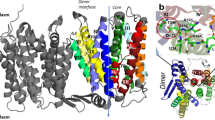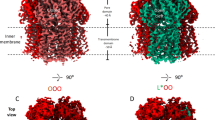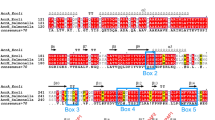Abstract
The AcrA–AcrB–TolC complex is the major multidrug efflux pump in Escherichia coli. The asymmetric structure of the trimeric inner-membrane component AcrB implies functional rotation of the monomers and a peristaltic mode of drug efflux. This mechanism suggests the occurrence of conformational changes in the periplasmic pore domain through the movements of subdomains during cycling of the monomers through the different states loose (L), tight (T) and open (O). We introduced cysteines at the interfaces of potentially moving subdomains, leading to disulfide bond formation as quantified by alkylation of free cysteines and MALDI-TOF analysis. Inhibition of pump function as a result of cross-linking caused increased susceptibility to noxious compounds and reduction of N-phenylnaphthylamine efflux. Regain of function for impaired mutants was obtained upon exposure to the reducing agent DTT. The results support the presence of the asymmetric AcrB trimer in E. coli membranes and the functional rotation mechanism.
This is a preview of subscription content, access via your institution
Access options
Subscribe to this journal
Receive 12 print issues and online access
$189.00 per year
only $15.75 per issue
Buy this article
- Purchase on Springer Link
- Instant access to full article PDF
Prices may be subject to local taxes which are calculated during checkout



Similar content being viewed by others
References
Poole, K. Efflux-mediated multiresistance in Gram-negative bacteria. Clin. Microbiol. Infect. 10, 12–26 (2004).
Zgurskaya, H.I. & Nikaido, H. Multidrug resistance mechanisms: drug efflux across two membranes. Mol. Microbiol. 37, 219–225 (2000).
Murakami, S. & Yamaguchi, A. Multidrug-exporting secondary transporters. Curr. Opin. Struct. Biol. 13, 443–452 (2003).
Eswaran, J., Koronakis, E., Higgins, M.K., Hughes, C. & Koronakis, V. Three's company: component structures bring a closer view of tripartite drug efflux pumps. Curr. Opin. Struct. Biol. 14, 741–747 (2004).
Koronakis, V., Sharff, A., Koronakis, E., Luisi, B. & Hughes, C. Crystal structure of the bacterial membrane protein TolC central to multidrug efflux and protein export. Nature 405, 914–919 (2000).
Murakami, S., Nakashima, R., Yamashita, E. & Yamaguchi, A. Crystal structure of bacterial multidrug efflux transporter AcrB. Nature 419, 587–593 (2002).
Pos, K.M., Schiefner, A., Seeger, M.A. & Diederichs, K. Crystallographic analysis of AcrB. FEBS Lett. 564, 333–339 (2004).
Murakami, S., Nakashima, R., Yamashita, E., Matsumoto, T. & Yamaguchi, A. Crystal structures of a multidrug transporter reveal a functionally rotating mechanism. Nature 443, 173–179 (2006).
Seeger, M.A. et al. Structural asymmetry of AcrB trimer suggests a peristaltic pump mechanism. Science 313, 1295–1298 (2006).
Mikolosko, J., Bobyk, K., Zgurskaya, H.I. & Ghosh, P. Conformational flexibility in the multidrug efflux system protein AcrA. Structure 14, 577–587 (2006).
Andersen, C. et al. Transition to the open state of the TolC periplasmic tunnel entrance. Proc. Natl. Acad. Sci. USA 99, 11103–11108 (2002).
Tikhonova, E.B. & Zgurskaya, H.I. AcrA, AcrB, and TolC of Escherichia coli form a stable intermembrane multidrug efflux Complex. J. Biol. Chem. 279, 32116–32124 (2004).
Touze, T. et al. Interactions underlying assembly of the Escherichia coli AcrAB-TolC multidrug efflux system. Mol. Microbiol. 53, 697–706 (2004).
Lobedanz, S. et al. A periplasmic coiled-coil interface underlying TolC recruitment and the assembly of bacterial drug efflux pumps. Proc. Natl. Acad. Sci. USA 104, 4612–4617 (2007).
Tikhonova, E.B., Wang, Q. & Zgurskaya, H.I. Chimeric analysis of the multicomponent multidrug efflux transporters from Gram-negative bacteria. J. Bacteriol. 184, 6499–6507 (2002).
Eda, S., Maseda, H. & Nakae, T. An elegant means of self-protection in Gram-negative bacteria by recognizing and extruding xenobiotics from the periplasmic space. J. Biol. Chem. 278, 2085–2088 (2003).
Pos, K.M. & Diederichs, K. Purification, crystallization and preliminary diffraction studies of AcrB, an inner-membrane multi-drug efflux protein. Acta Crystallogr. D Biol. Crystallogr. 58, 1865–1867 (2002).
Yu, E.W., McDermott, G., Zgurskaya, H.I., Nikaido, H. & Koshland, D.E., Jr. Structural basis of multiple drug-binding capacity of the AcrB multidrug efflux pump. Science 300, 976–980 (2003).
Sennhauser, G., Amstutz, P., Briand, C., Storchenegger, O. & Grutter, M.G. Drug export pathway of multidrug exporter AcrB revealed by DARPin inhibitors. PLoS Biol. 5, Acta Crystallogr. D Biol. Crystallogr. 5, e7 (2007).
Abrahams, J.P., Leslie, A.G., Lutter, R. & Walker, J.E. Structure at 2.8 A resolution of F1-ATPase from bovine heart mitochondria. Nature 370, 621–628 (1994).
Nikaido, H. Multidrug efflux pumps of Gram-negative bacteria. J. Bacteriol. 178, 5853–5859 (1996).
Lomovskaya, O. et al. Identification and characterization of inhibitors of multidrug resistance efflux pumps in Pseudomonas aeruginosa: novel agents for combination therapy. Antimicrob. Agents Chemother. 45, 105–116 (2001).
Colonna-Cesari, F. & Sander, C. Excluded volume approximation to protein-solvent interaction. The solvent contact model. Biophys. J. 57, 1103–1107 (1990).
Dombkowski, A.A. & Crippen, G.M. Disulfide recognition in an optimized threading potential. Protein Eng. 13, 679–689 (2000).
Murakami, S., Tamura, N., Saito, A., Hirata, T. & Yamaguchi, A. Extramembrane central pore of multidrug exporter AcrB in Escherichia coli plays an important role in drug transport. J. Biol. Chem. 279, 3743–3748 (2004).
Woodcock, D.M. et al. Quantitative evaluation of Escherichia coli host strains for tolerance to cytosine methylation in plasmid and phage recombinants. Nucleic Acids Res. 17, 3469–3478 (1989).
Miroux, B. & Walker, J.E. Over-production of proteins in Escherichia coli: mutant hosts that allow synthesis of some membrane proteins and globular proteins at high levels. J. Mol. Biol. 260, 289–298 (1996).
Sambrook, J., Fritsch, E.F. & Maniatis, T. Molecular Cloning: A Laboratory Manual (Cold Spring Harbor Laboratory Press, Cold Spring Harbor, New York, USA, 1989).
Datsenko, K.A. & Wanner, B.L. One-step inactivation of chromosomal genes in Escherichia coli K-12 using PCR products. Proc. Natl. Acad. Sci. USA 97, 6640–6645 (2000).
Schagger, H. & von Jagow, G. Tricine-sodium dodecyl sulfate-polyacrylamide gel electrophoresis for the separation of proteins in the range from 1 to 100 kDa. Anal. Biochem. 166, 368–379 (1987).
Molloy, P.L. Electrophoretic mobility shift assays. Methods Mol. Biol. 130, 235–246 (2000).
Kyhse-Andersen, J. Electroblotting of multiple gels: a simple apparatus without buffer tank for rapid transfer of proteins from polyacrylamide to nitrocellulose. J. Biochem. Biophys. Methods 10, 203–209 (1984).
Kraft, P., Mills, J. & Dratz, E. Mass spectrometric analysis of cyanogen bromide fragments of integral membrane proteins at the picomole level: application to rhodopsin. Anal. Biochem. 292, 76–86 (2001).
Acknowledgements
MALDI-TOF measurements were performed at the Functional Genomics Center Zurich (FGCZ). We thank P. Gehrig from the FGCZ for assistance with the MALDI-TOF instrument. This work was supported by grants of the TR-SFB Zürich-Konstanz (to K.D.), the ETH Zürich, EMDO Stiftung and the FK of the University of Zürich (to K.M.P.).
Author information
Authors and Affiliations
Contributions
M.A.S., C.v.B. and K.M.P. designed the experiments; M.A.S., C.v.B, T.E. and L.B. performed the experiments; M.A.S., F.V., K.D. and K.M.P. analyzed the data; M.A.S., K.D. and K.M.P. wrote the article.
Corresponding author
Supplementary information
Supplementary Text and Figures
Supplementary Figures 1–4, Supplementary Table 1 and Methods (PDF 673 kb)
Rights and permissions
About this article
Cite this article
Seeger, M., von Ballmoos, C., Eicher, T. et al. Engineered disulfide bonds support the functional rotation mechanism of multidrug efflux pump AcrB. Nat Struct Mol Biol 15, 199–205 (2008). https://doi.org/10.1038/nsmb.1379
Received:
Accepted:
Published:
Issue Date:
DOI: https://doi.org/10.1038/nsmb.1379
This article is cited by
-
Allosteric drug transport mechanism of multidrug transporter AcrB
Nature Communications (2021)
-
Antibiotic export by MexB multidrug efflux transporter is allosterically controlled by a MexA-OprM chaperone-like complex
Nature Communications (2020)
-
Crystal structures of multidrug efflux pump MexB bound with high-molecular-mass compounds
Scientific Reports (2019)
-
A uniform cloning platform for mycobacterial genetics and protein production
Scientific Reports (2018)
-
Mapping the Dynamic Functions and Structural Features of AcrB Efflux Pump Transporter Using Accelerated Molecular Dynamics Simulations
Scientific Reports (2018)



